ARL’s state-of-the art lab features a wide array of product reliability testing equipment to meet a vast range of client needs. View our equipment list.

ALTITUDE CHAMBER
Altitude Testing is performed to determine the ability of components and/or equipment to be stored, transported or used under low air pressure conditions. High altitude can cause problems in electronic devices as a result of trapped, expanding gases, increased corona effect and many others. Altitude considerations expand to telecommunication devices placed in higher elevations, satellite hardware, packaging and even medical devices. Products designed to operate in space or other vacuum areas need to be tested under the conditions they will encounter there. With almost no air to dissipate heating, temperature problems are exaggerated and any trapped gases in products are likely to cause severe problems. Our chambers and pumps are configured to produce both vacuum and temperature effects.
- Capabilities up to 100,000 feet, combined with high temperature
- Standards: IEC, Military & Others
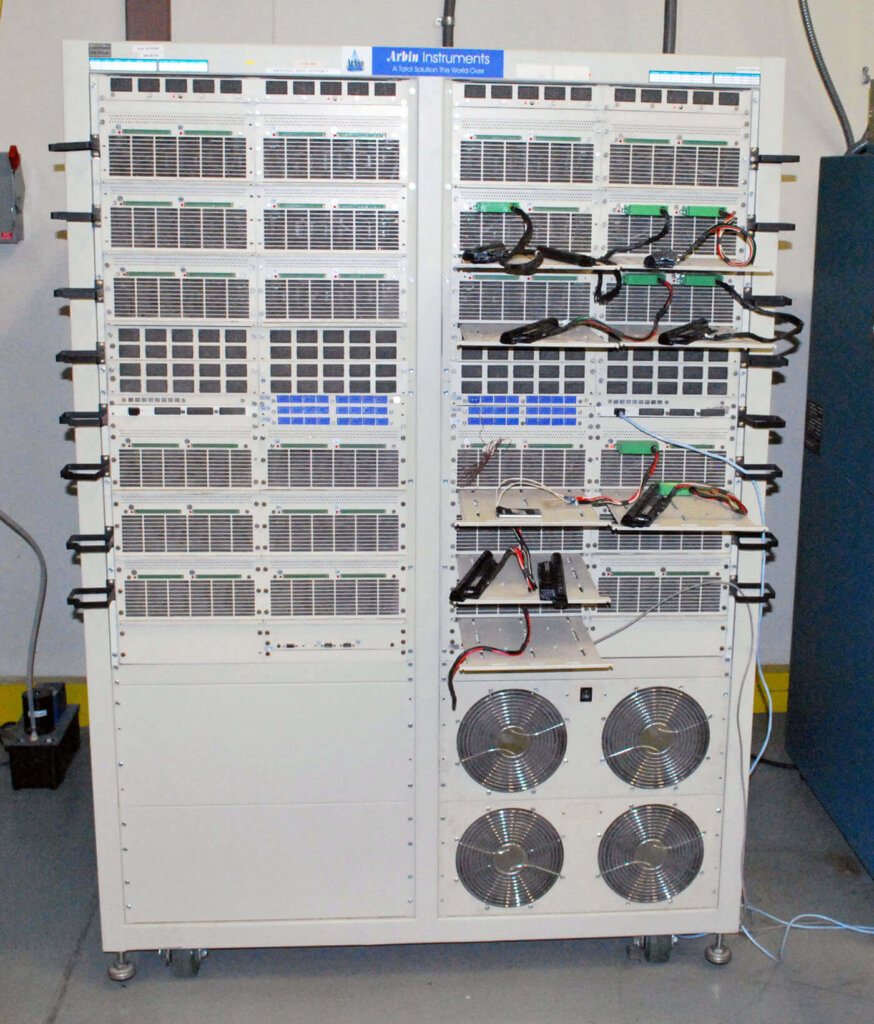
BATTERY LIFE CYCLE TESTERS
Battery Life Cycle Testing performs charge / discharge cycling of multiple cells or batteries simultaneously to obtain charge and discharge capacity, energy, DC internal resistance and other valuable information.
- Accelerated Life Test Simulation of Discharge Profile for Primary Batteries
- Completely Independent Channels allow Multiple Independent Tests
- Smart Charge & Discharge Communication from the battery pack Battery Management System
- 20 volts & 20 amps at each channel, with accuracy up to 0.02% for low power and 0.05% for high power applications
- Current Rise Times to 10us allowing for extremely reliable testing and response rates
- Channel Paralleling Channels to increase the current handling
capability of the system - Tests both Rechargeable & Primary Battery Applications for all chemistries
- Test standards are Client-Based on Application
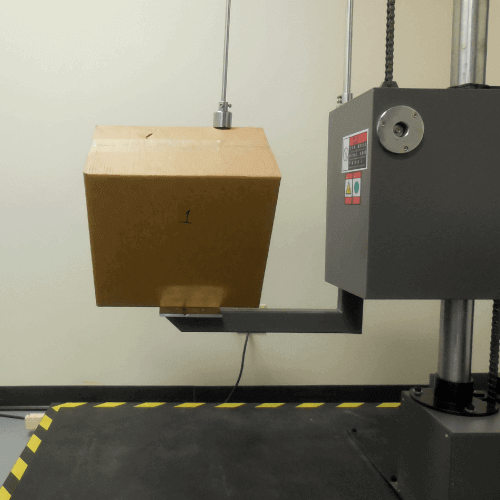
DROP TESTER
Drop Testing determines the ability of a package or product to withstand the stresses of handling drops by people and machinery in the distribution and use environment. Our drop test system allows you to thoroughly examine the effectiveness of package cushioning and its ability to protect your product, as well as other critical design attributes when exposed to all possible drop test orientations.
- Standards: ISTA, ASTM, IEC, Military & Others

DUST CHAMBER
Dust conditions are encountered in all areas of the world, and in ordinary industrial environments. Products need Dust Testing in order to discover their ability to withstand ingress by these contaminants by exposure to them. Items, such as dust-proof enclosures (NEMA, IP Ratings) and surface coatings, are subjected to various types of airborne contaminants, including fibrous dusts in our chambers.
- Ingress Protection
Dust must not be in a quantity that would impair safety or satisfactory operation. Product interior may be tested with or without vacuum pressure depending on application. - Investigation of the Seal Integrity of a Product
- Standards: IEC, NEMA, Military & Others
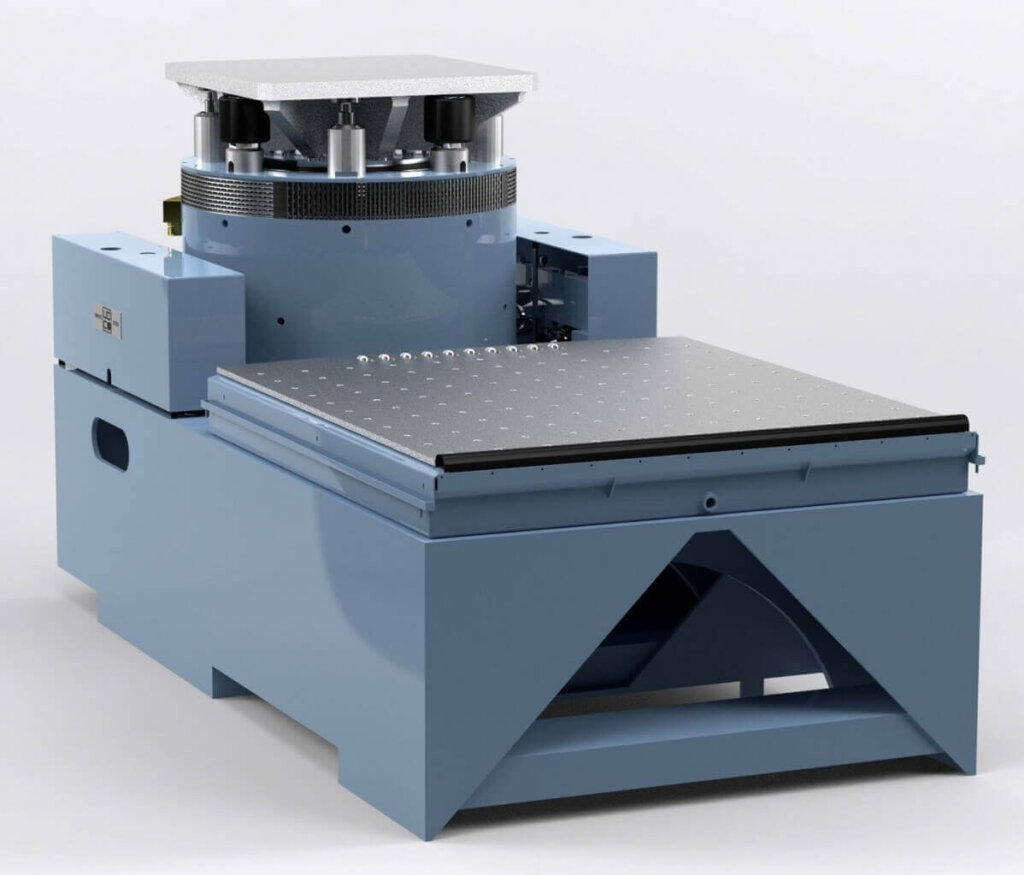
ELECTRODYNAMIC SHAKERS
To support the many stages of product manufacturing, the ARL testing labs use the Unholtz-Dickie and LING shaker systems. With Vibration Testing, products and product components can be tested during design, qualification and production stages. These shaker systems allow for testing of transportation and user mechanical stresses.
In a product’s design stage, weaknesses can be determined by performing a vibration test on the design prototype. During product qualification, vibration testing determines the adequacy of a product for a specific application or range of applications. When the product moves into the manufacturing stage, shaker systems are used to evaluate the quality of workmanship. The overall product quality can be assessed by using both destructive and non-destructive vibration testing.
- The Unholtz-Dickie Shaker includes a Slip Table (30” x 30”) to support large products in Multiple Axis
- Single Axis Frequency Range: 4 to 2000 Hz
- Force Pounding Rate: 6000 & 9000
- Random, Sine, Shock Testing
- Standards: ISTA, ASTM, IEC, Military & Others
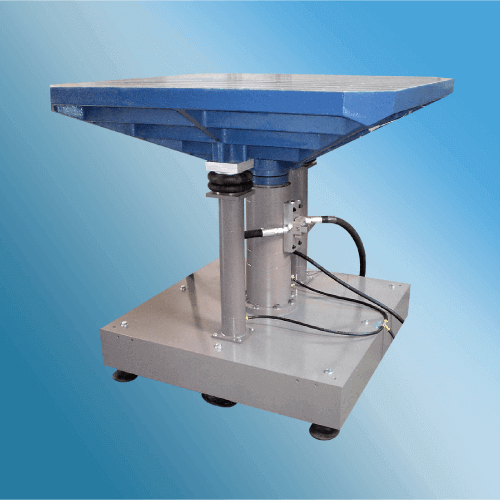
HYDRAULIC SHAKER
Vibration Testing can also be used to help design high-quality, cost-effective products and shipping containers. Using the Lansmont Hydraulic shaker system, product sensitivity to sine or random vibrations can be accurately measured throughout the testing process.
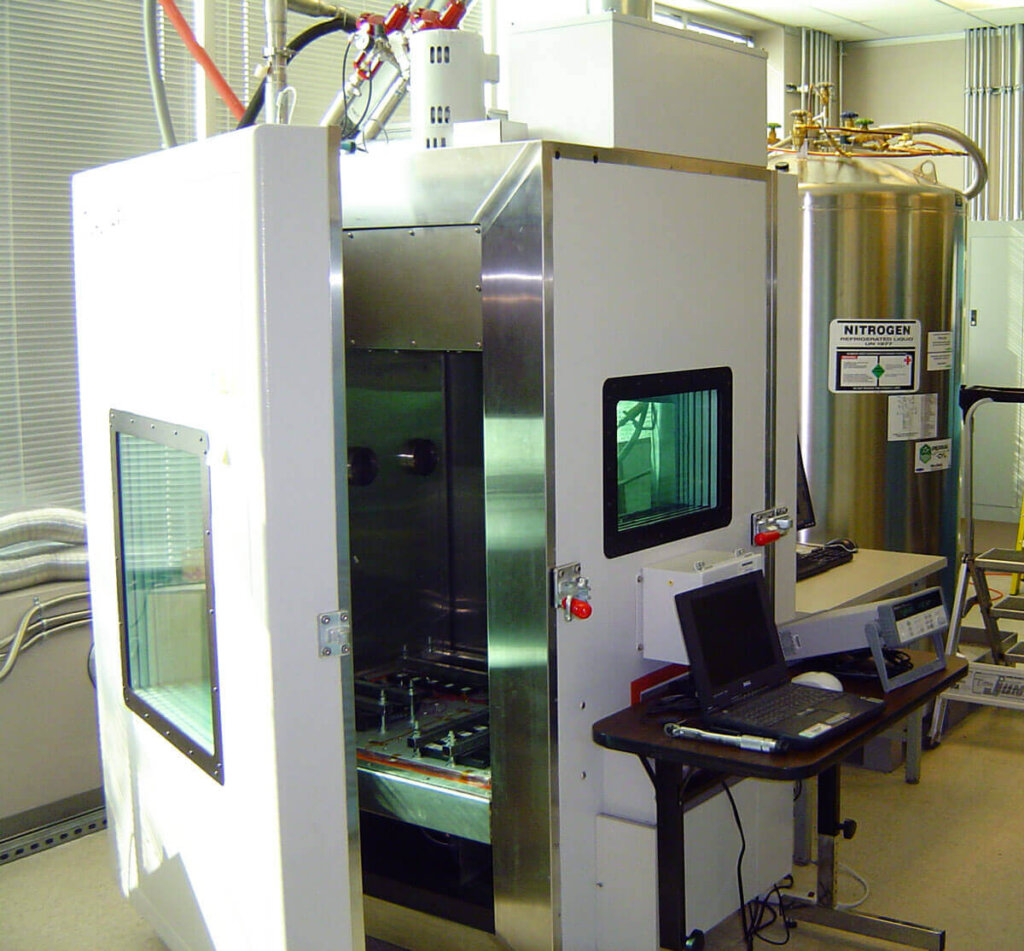
HALT / HASS CHAMBER
HALT is a design technique used to discover product weaknesses and improve design margins. The intent is to systematically subject a product to stress stimuli well beyond the expected field environments in order to determine and expand the operating and destruct limits of the product.
- Liquid Nitrogen Cooled
– 50KW Heaters / LN2 cooling
– Rapid thermal transitions:+60°C/min
– Thermal range of -100°C to 200°C - Repetitive Shock Vibration
– Pneumatic hammers repetitive impacts
– 6 degrees of freedom: 3 axes with simultaneous rotational energy
– Broad frequency band (2-10,000 Hz) - Combined Environment
– Thermal and Vibration
HASS is a production process comprising of a set of stresses beyond use environment performed on a product before it is shipped with the goal of finding manufacturing-related defects. The set of stresses combined together make up the screen.
- Increase Out-Of-Box Quality & Field Reliability
- Decrease Field Service & Warranty Costs
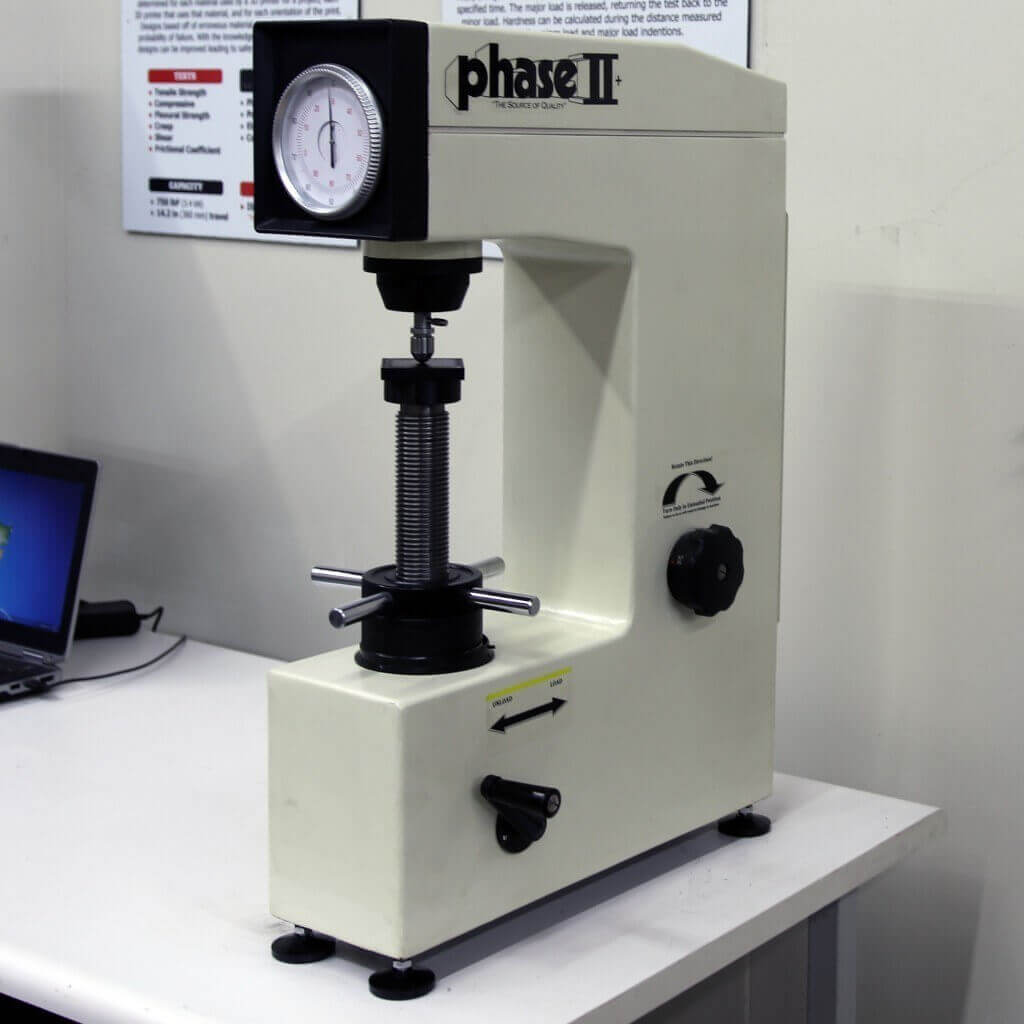
PHASE II+ ROCKWELL HARDNESS TESTER (MODEL NO. 900-331)
Hardness is a material’s resistance to indentation. The Rockwell hardness test method measures the permanent depth of an indentation created by a load applied to a material. Different indenters, such as diamond and ball indenters, can be used during this process depending on the test material. The process of hardness testing using the Rockwell method begins with the application of a minor load to the material to allow for a baseline depth of indentation to be measured. Then, a major load is applied to reach the total test load and is held for a specified time. The major load is released, returning the test back to the minor load. Hardness can be calculated during the distance measured between the minor load and major load indentions.
Materials:
- Metals
- Plastics
Capacity:
- Minor Load: 10Kgf
- Major Load: 60Kgf, 100Kgf, 150Kgf
- Vertical Capacity: 6.7 in
- Throat Depth: 6.6 in
Standards:
- Conforms to ASTM E-18, the most commonly used harness test method
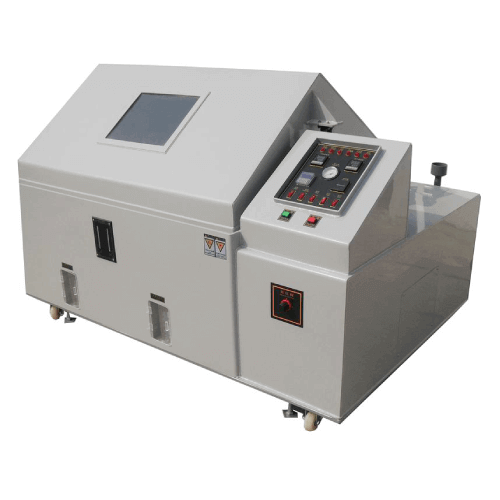
SALT SPRAY CHAMBER
Salt Fog is a specialized test used to evaluate the resistance to corrosion of paints, coatings or electrical connections. Our chambers provide exposure to a salt intensive atmosphere at temperatures of the customer’s choice.
Salt Spray is an accelerated corrosion test that produces a corrosive attack to determine the effectiveness of protective coatings and finishes on materials. It may also be applied to determine the effects of salt deposits on the physical and electrical aspects of material. This test is to be applied to compare the resistance to deterioration from salt mist of specimens of similar construction. It is useful for evaluating the quality and the uniformity of protective coatings.
- Temperature, Specific Gravity, pH and Fog Rate are controlled
- Standards: ASTM, IEC, Military & Others
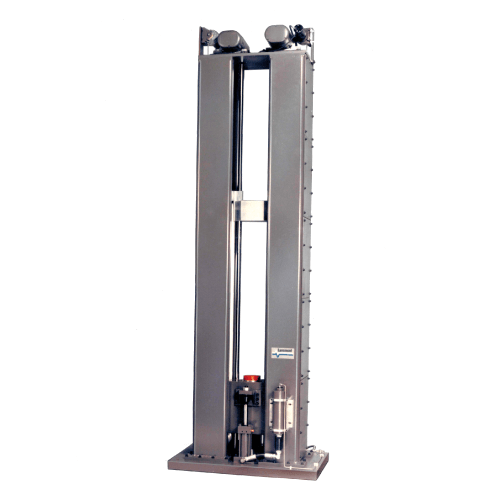
SHOCK TOWER & TESTER
Shock Testing of products and materials determines to what degree the items can physically and functionally withstand a relatively infrequent, short-time, moderately high-level force impulse that would be encountered in handling, transportation and service environments.
- Standards: IEC, Military & Others
- Our Shock Tower System (also known as “The Big Bopper”) is 20 feet tall and can produce 10,000 g of force

SOLAR CHAMBER
Solar Testing is used to evaluate material likely to be exposed to solar radiation in the open during its life cycle in hot climates, and when heating or actinic effects are of concern. This type of testing is valuable in evaluating the effects of direct exposure to sunlight, in determining the temperature increase (over ambient) of material caused by solar loading, and in simulating the ultraviolet effect of solar radiation. Degradation from solar energy may be attributable to other portions of the spectrum, particularly the ultraviolet. This testing conforms to MIL-STD requirements and the setup can be customized to accommodate special customer needs.
- Problems Identified: Fading of fabric and plastic color; checking, chalking and fading of paints; deterioration of natural and synthetic elastomers as well as polymers through photochemical reactions initiated by shorter wavelength radiation; deterioration and loss of strength by breakage of high-order bonds
- Standards: IEC, Military & Others
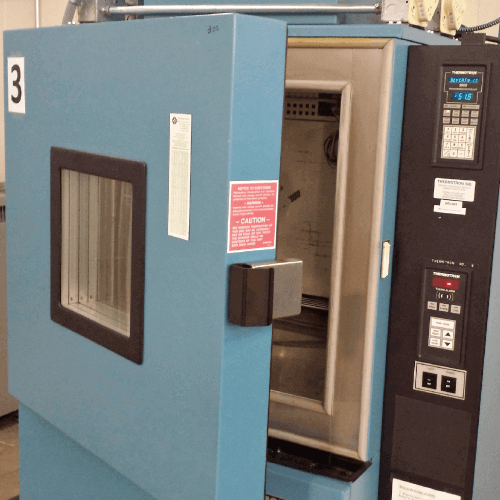
TEMPERATURE CHAMBERS
Our Temperature Chambers can perform all of the following test procedures:
Humidity Testing: This type of testing is intended to identify corrosion and moisture. Humidity causes electrical failures, accelerated rusting, paper feed problems in copiers or printers, and aids fungus growth. We can subject test units to high or low humidity conditions at steady or variable temperatures in order to determine the suitability of products, components or equipment for transportation, storage and use under varying conditions of humidity.
High Temperature Testing:High temperatures may temporarily or permanently impair performance of material by changing physical properties or dimensions of the material(s) of which it is composed.
Cold Temperature Testing:The object of this test is limited to the determination of the ability of components, equipment or other articles to be used, transported or stored at low and high temperatures.
Thermal Cyclic Stress Testing:The objective of this test is to invoke mechanical strain on components and materials to determine fitness for the application. The mechanical strain is a result of the dissimilar coefficient of thermal expansion for the various interfaces and bonds. Thermal cycles induce low-cycle fatigue mechanisms in metal bonds such as solder fillets in two subsequent steps; first, a small crack forms at locations where high strain amplitudes occur, such as menisci, edges, corners and transition interfaces. The number of thermal cycles needed to initiate a crack is a function of the strain amplitude, which in turn depends on the magnitude of the temperature change during the thermal cycle. Second, once the crack is initiated, it propagates during subsequent thermal cycles.
Thermal Shock Testing:This type of test refers to a very high rate of temperature change, typically 30 degrees C per minute or higher and is appropriate for testing packaging, aircraft parts, military hardware or electronics destined for rugged duty. Because almost all products are subject to shipping, this test may be appropriate to any part the will have to withstand an abrupt temperature change in a short period of time.
- Standards: IEC, Military & Others
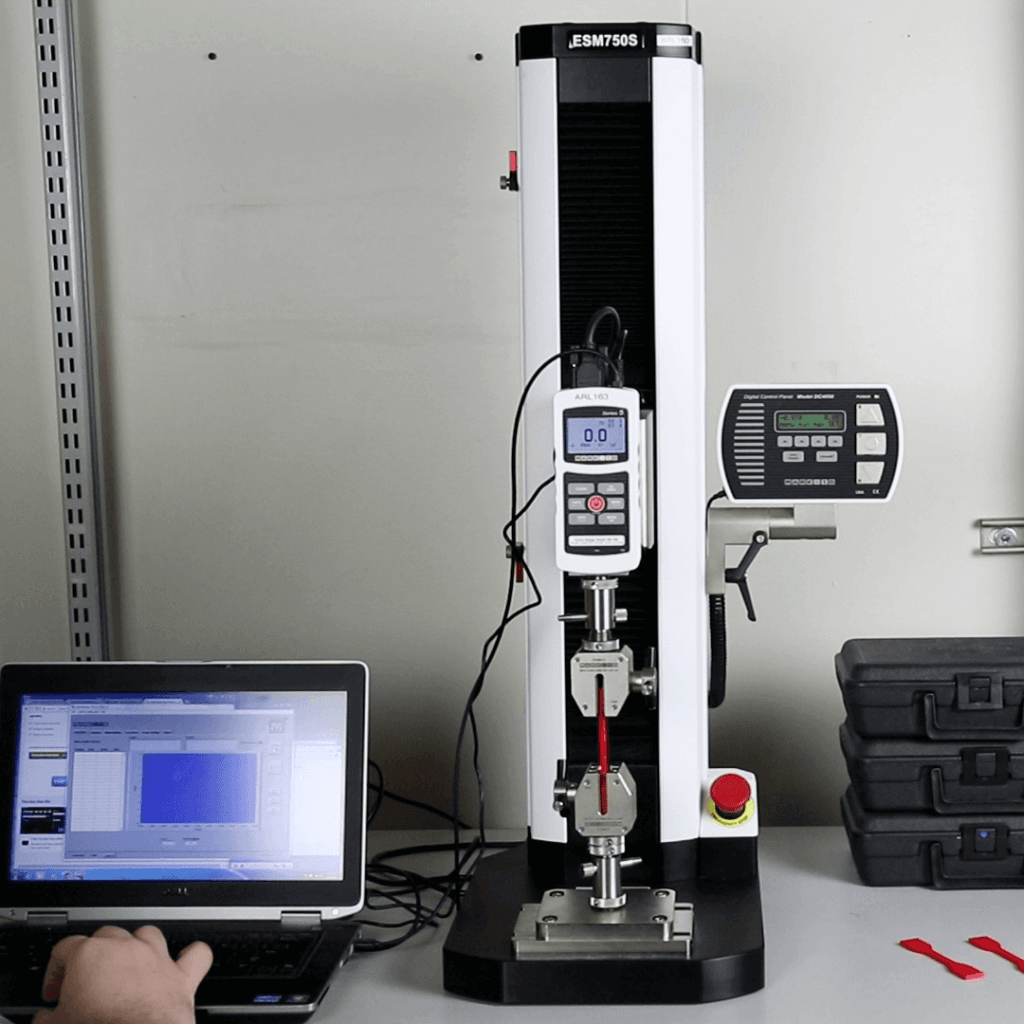
MARK-10 ESM750S TENSILE TESTER
Tensile Testing is a fundamental materials science test in which a sample is subjected to a controlled tension until failure. The results from the test are commonly used to select a material for an application, for quality control and to predict how a material will react under other types of forces.
The MARK-10 ESM750S Tensile Tester is a single-column force tester configurable for tension and compression measurement. For 3D printed products, the tests performed using the MARK-10 are essential for product design and improvement. Physical characteristics must be determined for each material used by a 3D printer for a project, each 3D printer that uses that material, and for each orientation of the print. Designs based off of erroneous material characteristics have a high probability of failure. With the knowledge of how the material works, designs can be improved leading to safer and more reliable products.
Tests:
- Tensile Strength
- Compressive
- Flexural Strength
- Creep
- Shear
- Frictional Coefficient
Materials Tested: (both 3D printed and conventional parts)
- Plastics
- Polymers
- Elastomers
- Ceramics
Capacity:
- 750 lbF (3.4 kN)
- 14.2 in (360 mm) travel
Standards:
- ISO 17296 – highest safety requirement for 3D printed parts

Hexagon Romer 3D Scanner
The Hexagon Romer Absolute Arm with Integrated Scanner 7725SI (RS4) is an all-purpose, portable 3D measurement tool for digitization, inspection and analysis. This metrology system captures 3D point data from a wide variety of surface types and can be utilized in almost any measurement application.

PEOPLE
Dedicated expertise working for you.
PARTNERSHIP
Successful business is a series of interlocking personal commitments.
PROCESS
Focused on innovation, entrepreneurship and community.
PURPOSE
Built to last, a proud member and resident of the community we serve.